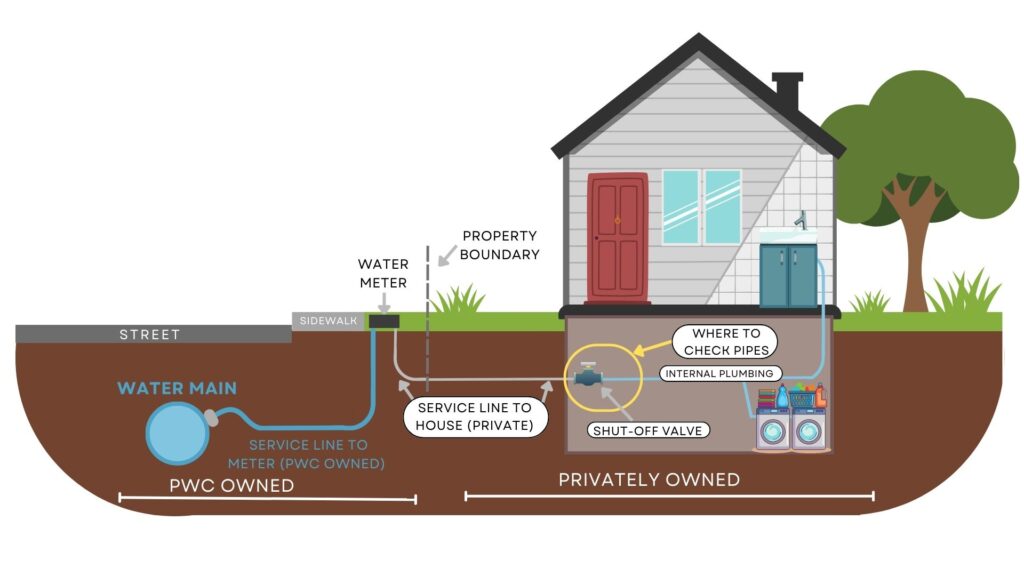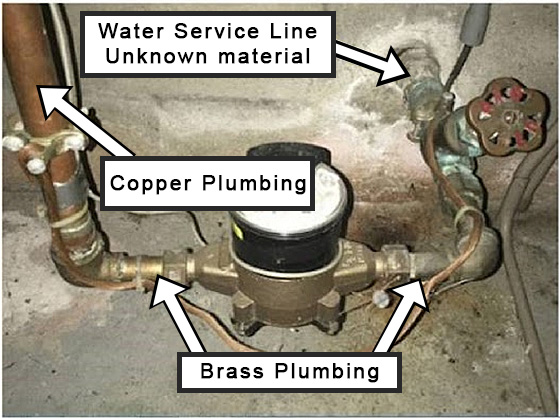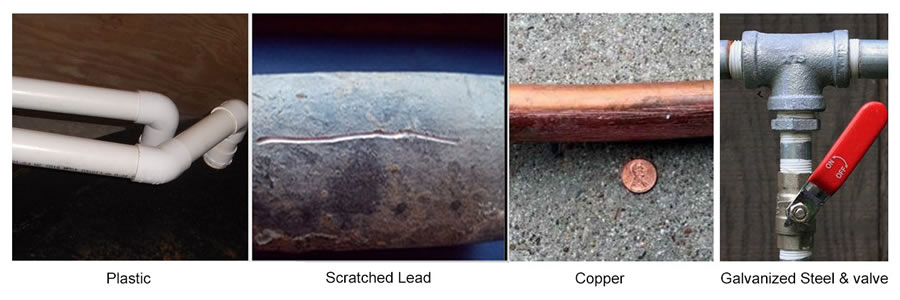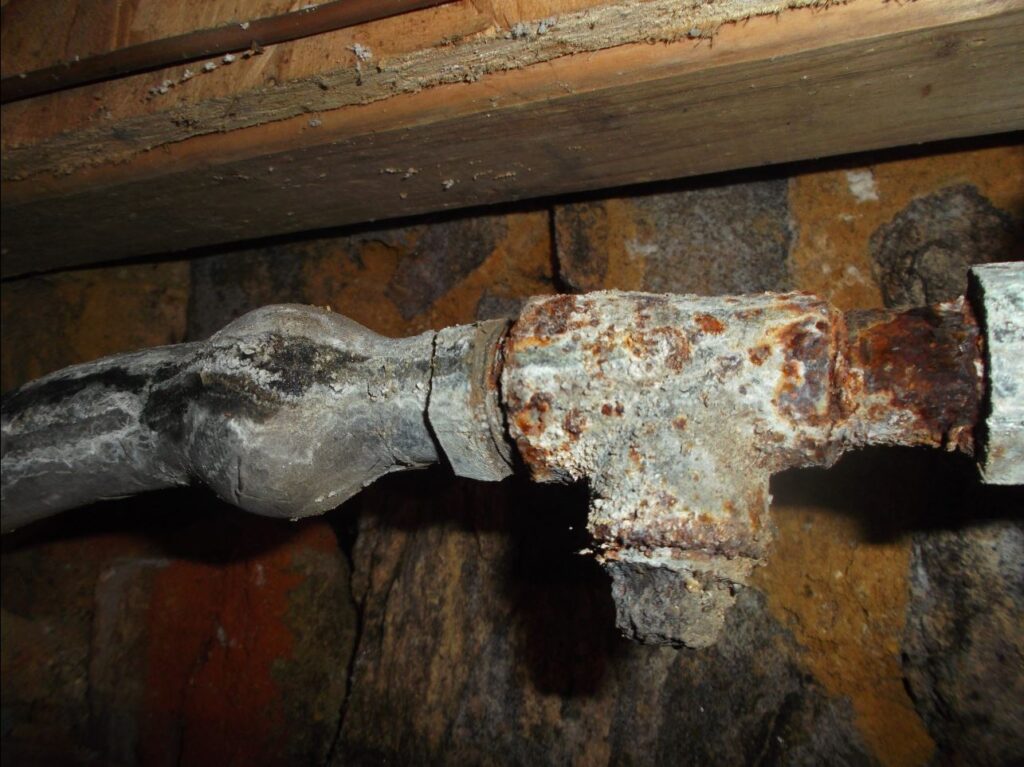Operation Clean & Clear FAQ
What is Operation Clean & Clear?
PWC is continuing its proactive measures to protect customers from lead exposure. In mid-2022, PWC began a water system improvement project – named Operation Clean and Clear – that identifies all water service lines in our distribution system and determines whether homes and businesses have any lead lines. Based on records and knowledge of our system, we anticipate there to be minimal instances of lead service lines, but we will be documenting all locations.
Any locations within our system that we can’t confirm with existing data, PWC will need customers to provide information about the types of materials used for the pipes connecting their property to PWC water mains. Through Operation Clean and Clear, PWC will be a resource for educating customers about potential lead materials in their homes and businesses and by 2024, will provide an online resource for identifying properties with lead lines/plumbing. These efforts will ensure PWC is in compliance with the latest revision of the Safe Drinking Water Act-Lead and Copper Rule.
What is the Safe Drinking Water Act?
The Safe Drinking Water Act (SDWA) was originally passed by Congress in 1974 to protect public health by regulating the nation’s public drinking water supply. The SDWA authorizes the Environmental Protection Agency (EPA) to set national health-based standards for drinking water to protect against both naturally-occurring and man-made contaminants that may be found in drinking water. The EPA, states, and water systems/utilities then work together to make sure that these standards are met.
What is the purpose of the Lead and Copper Rule?
Revisions to the Safe Drinking Water Act (SDWA) were signed into law in 1986 prohibited the use of lead piping in plumbing. Since then, there have been a series of changes and new regulations in continuing efforts to protect the public from lead exposure through drinking water.
The latest revision to the 1991 Lead and Copper Rule, lowers the level for required actions for utilities, revises sampling protocols, increases communications, and requires utilities to provide a public resource for the types of material used throughout the water system.
Because elevated levels of lead can cause serious health problems, especially for young children, the latest revisions to the EPA rule include additional focus on schools and day cares. PWC will be working with the Health Department, local school officials, and local day cares to meet sampling requirements.
What has PWC been doing about potential lead in drinking water?
PWC’s drinking water meets or surpasses all EPA drinking water standards. PWC was the first utility in North Carolina to earn the EPA Director’s Award for our extra efforts in providing clean, safe drinking water and has maintained that prestigious recognition for 20 consecutive years.
Since 1991, PWC has participated in the lead and copper sampling program as required by SDWA. As a result, PWC implemented a corrosion control program to stop lead from the pipes and fixtures from entering the water system. This corrosion control program has been successful in that all of PWC’s samples are well below the EPA mandated thresholds for lead in drinking water.
In 1997, PWC obtained reduced monitoring based on three years of sampling data that indicated our corrosion control program was effective and our system followed the requirements of the SDWA pertaining to lead and copper. Since that time, PWC tests a minimum of 50 locations once every three (3) years. The most recent testing was 2020 in which no lead was detected. Additionally, PWC collects tap water samples for customers on a requested basis.
How is PWC Checking Pipe Materials?
PWC reviewed existing records and compiled an inventory of service laterals (water lines connecting water mains to the customer) on both sides of the water meter. PWC has also completed an inventory of service laterals connected to local schools and licensed daycares. Click on the links below for the inventories for schools and daycares.
Since some customers have service laterals installed more than 35 years ago, records related to service laterals no longer exist. In order to complete the inventory, PWC conducted site surveys at select water meters of customers where records no longer exist. This information was compiled into a database to help engineer’s predict the types of service lines in local neighborhoods. For the remainder of our customers where the materials of the service lines are unknown, customers are being asked to identify the type of pipes in the home and fill out a self-verification form online or by returning a prepaid postage postcard.
How did PWC perform a Site Survey?
PWC contracted with a company to perform a Subsurface Utility Engineering dig at select water meters across the city to visually identify the types of materials used in the service laterals connecting the customer to PWC’s water main. The contractor used a vacuum truck to excavate holes 12 to 18 inches in diameter on either side of the water meter to perform a visual inspection of the pipes. Once the inspection was completed, the hole was refilled and crews replaced the grass plug removed at the start of the dig. The dig was completed in less than a day at each location.
If PWC did a Site Survey at my property, will I need to do a self-verification form?
No, after a site survey identified the types pipes used in the service lines, the results were entered into the database and a copy of the results were mailed to property owner and occupant.
How can I find out if my home’s service lines information is in the database?
Fayetteville PWC has contracted with 120Water to maintain a searchable database via an interactive map. The map will be posted on the Operation Clean & Clear webpage as well as 120Water’s website.
What happens if I choose to not enter my the types of materials used in service lines into the database?
The new changes to the Lead and Copper Rule require water providers to do an annual notification to all customers with lead, galvanized steel, or unknown service lines. This notification will be required until the water service line containing lead is replaced or the materials used in the service line is verified to not contain lead.
What is PWC’s Corrosion Control Program?
PWC corrosion control measures meets our exceeds the variety of water quality levels mandated by the Environmental Protection Agency (EPA) and the North Carolina Department of Environmental Quality (NCDEQ), formally known at the North Carolina Department of Environmental and Natural Resources (NCDNER). PWC implemented the use of zinc-orthophosphate for corrosion control in 1994 for our water distribution system. Following the implementation and based on positive results of its use, in January of 1997, after reviewing three years of lead level analysis, the NCDENR notified PWC that they considered our water system’s corrosion control to be optimized.
Because of our optimized corrosion control, PWC’s requirements of our lead and copper monitoring sites and analysis frequency was reduced by state authorities. This reduced monitoring stage came with a list of water quality parameters that we were required to monitor, as well as set ranges that could not be exceeded. The water quality parameters are such things as pH, corrosion inhibitor dose, alkalinity, and calcium levels.
Along with maintaining these water quality parameters, PWC has a continuous corrosion coupon analysis system in place. Eight mid-steel coupons are placed throughout the distribution system where they remain in contact with our drinking water for a period of 90 days. After 90 days, the steel coupons are removed and sent to a lab to measure what changes have occurred in “corrosion rate factor”. We continuously monitor this factor for any changes in the corrosivity of our water. Since switching to zinc-orthophosphate, we remained in compliance with the Lead and Copper Rule, and we have maintained the above-mentioned water quality parameters within the state’s established ranges for optimized corrosion control.
In 2008, as a result of our change in primary coagulants from Aluminum Sulfate to Ferric Sulfate in our water treatment process, we performed another corrosion control study to ensure that our change in coagulants had not adversely affected our corrosion control plan. The year-long bench-scale test at the P.O. Hoffer Water Treatment Facility compared the zinc-orthophosphate we were using was compared to four other leading corrosion inhibitor blends. The orthophosphate that we had been using since January 1994 was shown to still be the best inhibitor for corrosion control so that PWC remained in compliance with the Lead and Copper Rule, and have maintained the above-mentioned water quality parameters within the established ranges for optimized corrosion control.
How does lead get into drinking water?
Lead enters from a building or residence’s plumbing system. It may be in various parts of the plumbing system (such as lead solder, brass fixtures, and lead or galvanized pipes) and leach into water standing in the plumbing system. The amount of lead in drinking water depends on how corrosive the water is and what materials the plumbing system is made of. Even new plumbing fixtures can leach lead into drinking water. The longer water stands in the plumbing system, the more lead it can absorb.
How do you identify lead pipes?
Service laterals are pipes that connect main water lines to an individual home or business. While changes to the SWDA went into effect in 1987 banning lead piping, known lead lines installed prior to 1987 have been replaced over the years, PWC has nearly 100,000 water laterals in its system that require documentation.
Based on records and knowledge of the PWC system, we anticipate there to be minimal instances of lead service lines, but we will be documenting all locations. Any locations within our system that we can’t confirm with existing data, will require PWC and our contractors to conduct site surveys at those customer locations.
In addition to PWC service lines, new rules will require the identification of lead materials that may exist on the customer’s water line that connects the PWC meter to their home or business. While PWC is responsible for providing high quality drinking water distributed through the PWC system, it cannot control the variety of materials used on private property nor does it have any existing records to verify if lead may exist on private property. Copper piping with lead solder as well as lead service lines are more likely to be found in homes built before 1987. Among homes without lead service lines, brass or chrome-plated brass faucets may also create lead exposure.
Identifying the types of pipes are used in your home’s plumbing can be done easily; you will need a flashlight, a magnet, and a tool to scratch the pipes with, like a flat head screwdriver. The first step is to go to the basement or crawlspace of your home closest to the water main, which typically runs along the street. Look for the pipe coming through the wall or ground into your home and connecting to your homes plumbing.


Visually examine the service line coming into your home. Plastic pipes are fairly easy to visually identify, but metal pipes may need you to do the scratch test to tell the difference.

- Brass- Brass pipes are metal pipes and brown or dull yellow colored with green corrosion spots. Scratches on a brass pipe are gold colored. Brass pipes use threaded connections and magnets will not stick.
- Plastic- Plastic pipes can be white, black, red, or blue in color and smooth to the touch. Plastic is easy to scratch with your tool and magnets will not stick to plastic pipes.
- Lead- Lead pipes are made of metal and easy to scratch with your tool , scratches will be shiny and silver colored. Magnets will not stick to lead and lead pipes will often bulge where it connects to the homes plumbing.
- Copper- Copper pipes are metal pipes and dull brown or green in color. When scratched, it will be the same color as a penny. Magnets will not stick to copper.
- Galvanized Steel- Galvanized steel are metal pipes, gray or silver in color, and not easy to scratch with your tool. Additionally, magnets will stick to the metal and steel uses threaded connections.

How can I learn more about PWC’s water quality?
PWC’s Annual Water Quality Report is available online faypwc.com/water-quality-report/. It is released annually in May. PWC provides other water quality updates through its website and customer communications throughout the year.
What is a service lateral?
A service lateral is the pipe is between the main and the house. In PWC’ service area, there are two (2) components to the service lateral – the section between the main and the meter (typically located at the right-of-way line), and the section between the meter and house. PWC is responsible for the section from the main up to and including the meter, while the property owner is responsible for the section between the right-of-way and the house.
What is a gooseneck?
A gooseneck is a small piece of lead pipe that connects galvanized water service lines to the water mains. Prior to the 1960’s, PWC may have installed lead goosenecks as part of the galvanized water service. From the mid-1960’s, PWC installed polyethylene (a type of plastic) for our portion of the water main. Since 2007, PWC has utilized copper piping for the PWC-portion of the water service lateral. As part of our in-going maintenance and replacement programs, as we discover galvanized piping (and any lead goosenecks), the PWC-owned portion of the service lateral is replaced. All water service lateral piping since 1990 – on both the customer side and PWC’s side – does not contain lead piping. All of the known lead goosenecks have been removed.
What is galvanized steel?
Galvanized steel is regular steel sheets that have been coated in zinc to make them corrosion resistant. Regular steel is made of iron which will rust when exposed to moisture. PWC stopped using galvanized piping for water services in the 1960’s. Galvanized services that have have been found in our system since then have been replaced.
Does our water system have goosenecks and galvanized steel?
It is possible that PWC’s water system has goosenecks and galvanized steel. Prior to the early 1960’s, PWC did install galvanized water service lines between the main and the meter. Some of those galvanized lines may have lead goosenecks. As part of the revised Lead and Copper Rule, PWC is required to complete an inventory of all water service laterals, from the main to the house. As we perform our maintenance and replacement activities, galvanized services (and any lead goosenecks) are removed and replaced, from the main to the meter. However, the LCR requires water systems to also replace all galvanized service lines that used to be connected to those lead goosenecks.
Has the Lead and Copper Rule been effective?
Since the Lead and Copper Rule has been implemented, lead and copper levels have decreased by over 90% in the United States. The initial Lead and Copper Rule went into effect in 1991. The revised rule was implemented in 2021, with an effective date of October 16, 2024.
What is PWC responsible for replacing?
PWC is responsible for replacing its portion of the service line from the main to the meter, if the material is lead (highly unlikely) or galvanized. If the material is plastic or copper, it is not required to be replaced under the Revised Lead and Copper Rule. PWC is replacing it with copper.
What is PWC using to replace the lead pipes?
PWC is replacing its portion of the service line (from the main to the meter) with copper.
Am I responsible for replacing anything?
From the meter to the house is the customer’s responsibility. Typically, the replacement materials are copper or PVC. The replacement materials need to be in compliance with the State Plumbing Code.
How do we know the replacement material is safe?
The replacement material (copper) does not contain lead (since 2014, all materials used in plumbing are to be lead free), and PWC’s corrosion control program will help ensure that no chemicals from the replacement material leach into the water. This applies to both the PWC side and the customer side of the service line.
What has PWC been doing when a lead pipe is found?
Anytime PWC finds a lead service line on our side of the service, it is replaced with copper from the main to the meter. We also note where the lead material was found, so we can be aware that more lead material may be in that area.
How long does it take to replace the line?
Typically, it takes PWC less than a day to replace the lead section from the main to the meter. It should take about the same amount of time to replace from the meter to the house, but that may depend on the installer.
What happens to the lead pipes once they are removed?
PWC properly disposes of lead pipes in accordance with state guidelines.
Can lead pipes be recycled?
Since exposure to lead has serious health effects, it should not be re-used.
Source: PWC, NCDEQ, EPA


